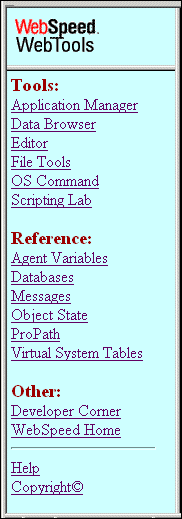
|
WebTool
|
Description
|
|
Application Manager
|
Contains the following utilities:
|
|
Data Browser
|
Allows you to work with the contents of databases connected to the WebSpeed broker. It contains the following utilities:
|
|
Editor
|
Functions as a basic, single-document text editor. Only one file can be edited at a time. If you attempt to open a new file, the text-entry frame is checked for changes. If there are any changes, you are prompted to save or ignore those changes before a new file is opened.
|
|
File Tools
|
Provides a directory listing from which you can view, open, run, compile, extract, or delete files in the selected directory. By default, File Tools initially displays a view of your working directory. Once you have created some of your own Web objects and procedure files, you can use the File Tools options to manage and maintain files either in your working directory or in another directory.
|
|
OS Command
|
Allows you to enter operating system commands. Commands execute in the operating system context of the machine where a WebSpeed Transaction Server is running in development mode. Command output is displayed below the command entry field.
The OS Command WebTool also allows you to run single-line command scripts. You can create these scripts in any text editor, but the file can only have one line (no carriage returns). Save them in install_dir/src/web/scriptswith a .os filename extension. After you create .os files in that directory, their names appear in the OS Command WebTool frame. After you select a script and choose Load Script, the script's contents appear in the command entry field. Choose Submit to execute.
Note: WebSpeed does not maintain context from one command to the next. Therefore, some commands (like changing your working directory, for example) do not execute. You get an error message stating that the command generated no output.
|
|
Scripting Lab
|
Allows you to enter SpeedScript, SQL, JavaScript, VBScript, or HTML code and run it on a WebSpeed Transaction Server that is running in development mode. You can use the Scripting Lab to test your code. You can copy your tested code into a Web object (by performing a cut-and-paste operation), but you cannot save code directly in the Scripting Lab.
The Scripting Lab also contains small code samples.
|
|
Agent Variables
|
Displays current environmental variables including:
|
|
Databases
|
Allows you to look up information about the database schema of any database connected to the WebSpeed agent. The Databases tool presents a view of the database on the server machine (which might be a different database from the one the AppBuilder is connected to). You can use the Databases tool to view:
|
|
Messages
|
Allows you to access information about error messages generated by WebSpeed. When you enter a message number, it displays a description of the message.
|
|
Object State
|
Allows you to view the state of procedures that a WebSpeed agent is running.
When you select an object state link, a table appears containing the name of each persistent object running on the WebSpeed agent and a description of the type and state of the object.
|
|
ProPath
|
Displays a list of the directories contained in the PROPATH environment variable. The PROPATH environment variable specifies where the WebSpeed agent will search to locate the file it has been requested to run. You can use the ProPath tool to view and verify the directories included in the PROPATH. You can also use the ProPath tool to open a directory in the File Tools tool.
|
|
Virtual System Tables
|
Allows you to examine the status of a database and monitor its performance.
|
|
Developer's Corner
|
Links to the Progress Communities WebSpeed Forum: http://communities.progress.com/pcom/community/psdn/openedge/webspeed
|
|
Help
|
Contains links to WebTools help topics.
|